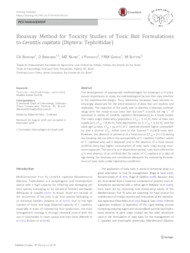Bioassay method for toxicity studies of toxic bait formulations to Ceratitis capitata (Diptera: Tephritidae).
Bioassay method for toxicity studies of toxic bait formulations to Ceratitis capitata (Diptera: Tephritidae).
Author(s): BARÔNIO, C. A.; BERNARDI, D.; NUNES, M. Z.; PASINATO, J.; GARCIA, F. R. M.; BOTTON, M.
Summary: The development of appropriate methodologies for bioassays is of paramount importance to study the methodological factors that may interfere in the experimental design. Thus, laboratory bioassays have become increasingly important for the determination of data that are realistic and replicable. The objective of the study was to develop a bioassay methodology with the ready-to-use toxic bait Success ? 0.02CB, 96 mg L−1 of spinosad, in adults of Ceratitis capitata (Wiedemann) as a study model. The insect origin laboratory population, LT 50= 11.16 h), time of toxic bait supply (4 h, LT 50= 16.85 h), food deprivation (12 h, LT 50= 15.55 h), and the adult age (5 days, LT 50= 35.31 h) of C. capitata showed higher susceptibility and a shorter LT 50 lethal time to the Success? 0.02CB toxic bait. However, the absence or presence of a food source (LT 50≈31.17 h) during the bioassay did not affect the susceptibility of C. capitata. Further, adults of C. capitata who were deprived and in the absence of a food source (artificial diet) had higher consumption of toxic baits (mg) during treatment exposure. The use of a 12-h deprivation period, toxic baits offered for 4 h, and absence of an artificial diet for adults of C. capitata at 5 days of age during the bioassay are considered adequate for evaluating formulations of toxic baits under laboratory conditions. Keywords: Toxicity, methodology, spinosad, Mediterranean fruit fly
Publication year: 2018
Types of publication: Journal article
Unit: Embrapa Grape & Wine
Keywords: Mediterranean fruit fly, Methodology, Spinosad, Toxicity
Observation
Some of Embrapa's publications are published as ePub files. To read them, use or download one of the following free software options to your computer or mobile device. Android: Google Play Books; IOS: iBooks; Windows and Linux: Calibre.
Access other publications
Access the Agricultural Research Database (BDPA) to consult Embrapa's full library collection and records.
Visit Embrapa Bookstore to purchase books and other publications sold by Embrapa.

